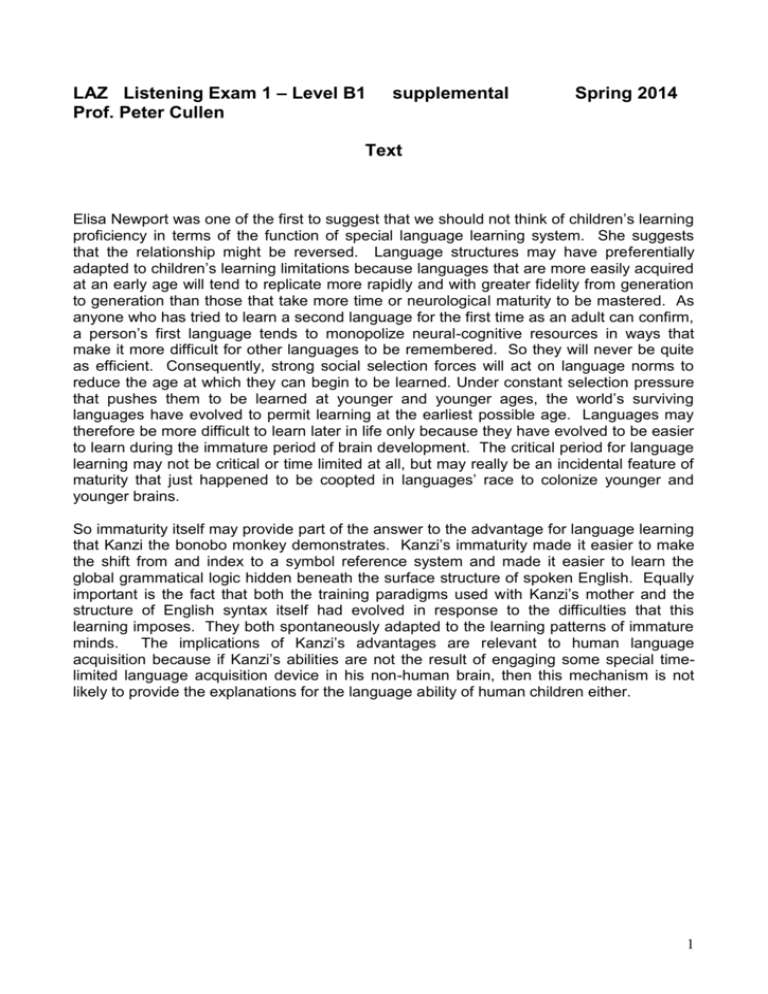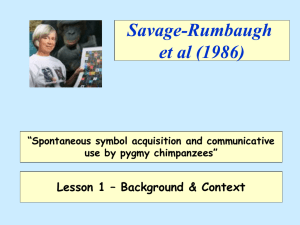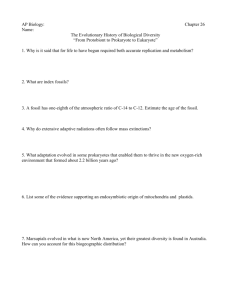LAZ B1 Listening Exam 1 05 2014 supplemental exam
advertisement

LAZ Listening Exam 1 – Level B1 Prof. Peter Cullen supplemental Spring 2014 Text Elisa Newport was one of the first to suggest that we should not think of children’s learning proficiency in terms of the function of special language learning system. She suggests that the relationship might be reversed. Language structures may have preferentially adapted to children’s learning limitations because languages that are more easily acquired at an early age will tend to replicate more rapidly and with greater fidelity from generation to generation than those that take more time or neurological maturity to be mastered. As anyone who has tried to learn a second language for the first time as an adult can confirm, a person’s first language tends to monopolize neural-cognitive resources in ways that make it more difficult for other languages to be remembered. So they will never be quite as efficient. Consequently, strong social selection forces will act on language norms to reduce the age at which they can begin to be learned. Under constant selection pressure that pushes them to be learned at younger and younger ages, the world’s surviving languages have evolved to permit learning at the earliest possible age. Languages may therefore be more difficult to learn later in life only because they have evolved to be easier to learn during the immature period of brain development. The critical period for language learning may not be critical or time limited at all, but may really be an incidental feature of maturity that just happened to be coopted in languages’ race to colonize younger and younger brains. So immaturity itself may provide part of the answer to the advantage for language learning that Kanzi the bonobo monkey demonstrates. Kanzi’s immaturity made it easier to make the shift from and index to a symbol reference system and made it easier to learn the global grammatical logic hidden beneath the surface structure of spoken English. Equally important is the fact that both the training paradigms used with Kanzi’s mother and the structure of English syntax itself had evolved in response to the difficulties that this learning imposes. They both spontaneously adapted to the learning patterns of immature minds. The implications of Kanzi’s advantages are relevant to human language acquisition because if Kanzi’s abilities are not the result of engaging some special timelimited language acquisition device in his non-human brain, then this mechanism is not likely to provide the explanations for the language ability of human children either. 1 LAZ Listening Exam 1 – Level B1 supplemental Spring 2014 ______/30 Prof. Peter Cullen ___________________________________________ Name, Date, and Registration Number Questions: You do not have to use complete sentences! This is a listening exam. SIMPLE AND CORRECT IS BETTER THAN COMPLICATED AND WRONG. 1. Who was Elisa Newport? 2. What do languages that can be easily acquired at an early age tend to do? 3. How do strong social selection forces act on language norms? 4. Why may languages be more difficult to learn later in life? 5. What made it easier for Kanzi the monkey to make the shift from and index to a symbol reference system? ______/20 True or False: Write “True” or “False” in the space next to each statement 1. Newport suggests that languages may have evolved to adapt to children’s learning limitations. ________________ 2. As an adult, a person’s first language tends to monopolize neurological resources so it is more difficult to learn another language. ________________ 3. the world’s surviving languages have evolved to permit learning at the earliest possible age. ________________ 4. Kanzi is a mature Rhesus monkey. ________________ 5. The implications of Kanzi’s learning advantages are not relevant to our understanding of human language learning. ________________ ______/10 2 LAZ Listening Exam 1 – Level B1 Prof. Peter Cullen supplemental Spring 2014 Answer Sheet 1. Who was Elisa Newport? one of the first to suggest that we should not think of children’s learning proficiency in terms of the function of special language learning system 2. What do languages that can be easily acquired at an early age tend to do? to replicate more rapidly and with greater fidelity from generation to generation than those that take more time or neurological maturity to be mastered 3. How do strong social selection forces act on language? Act on language norms to reduce the age at which they can begin to be learned 4. Why may languages be more difficult to learn later in life? they have evolved to be easier to learn during the immature period of brain development 5. What made it easier for Kanzi the monkey to make the shift from and index to a symbol reference system? Her immaturity True or False: Write “True” or “False” in the space next to each statement 1 2 3 4 5 T T T F F 3





